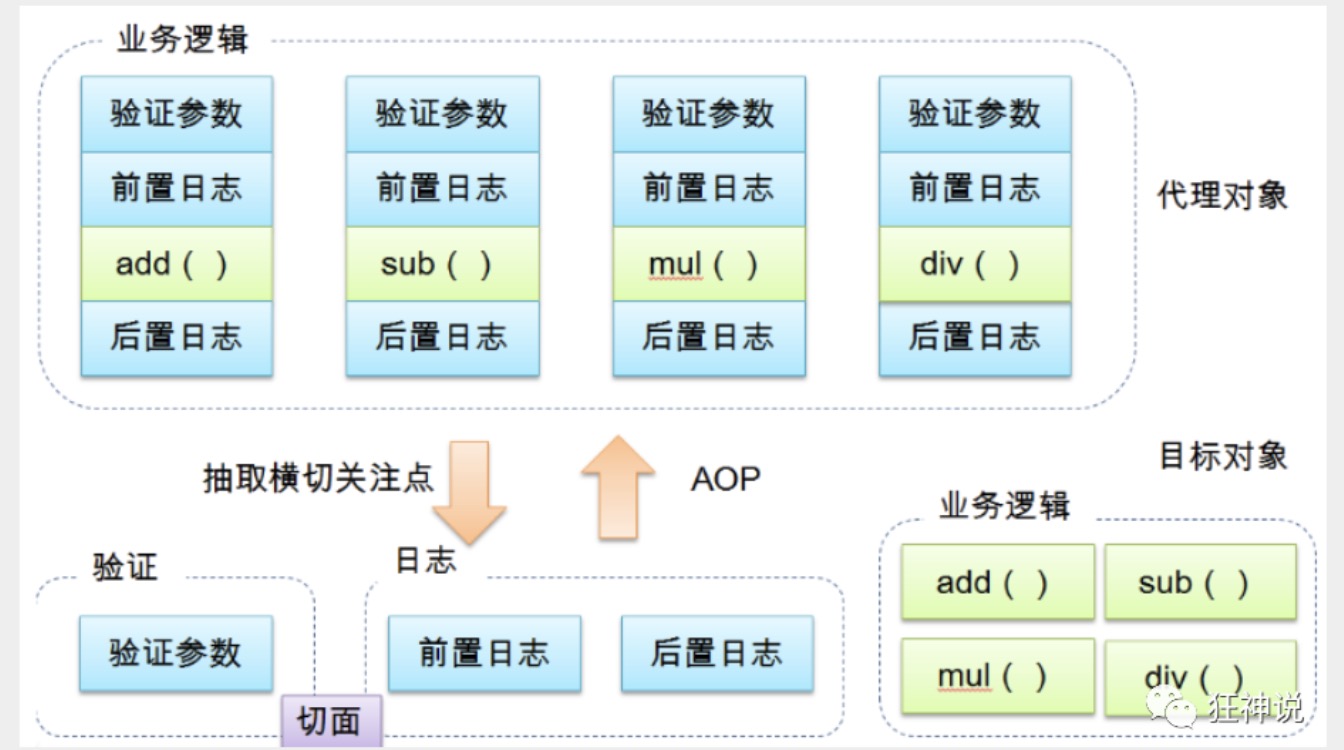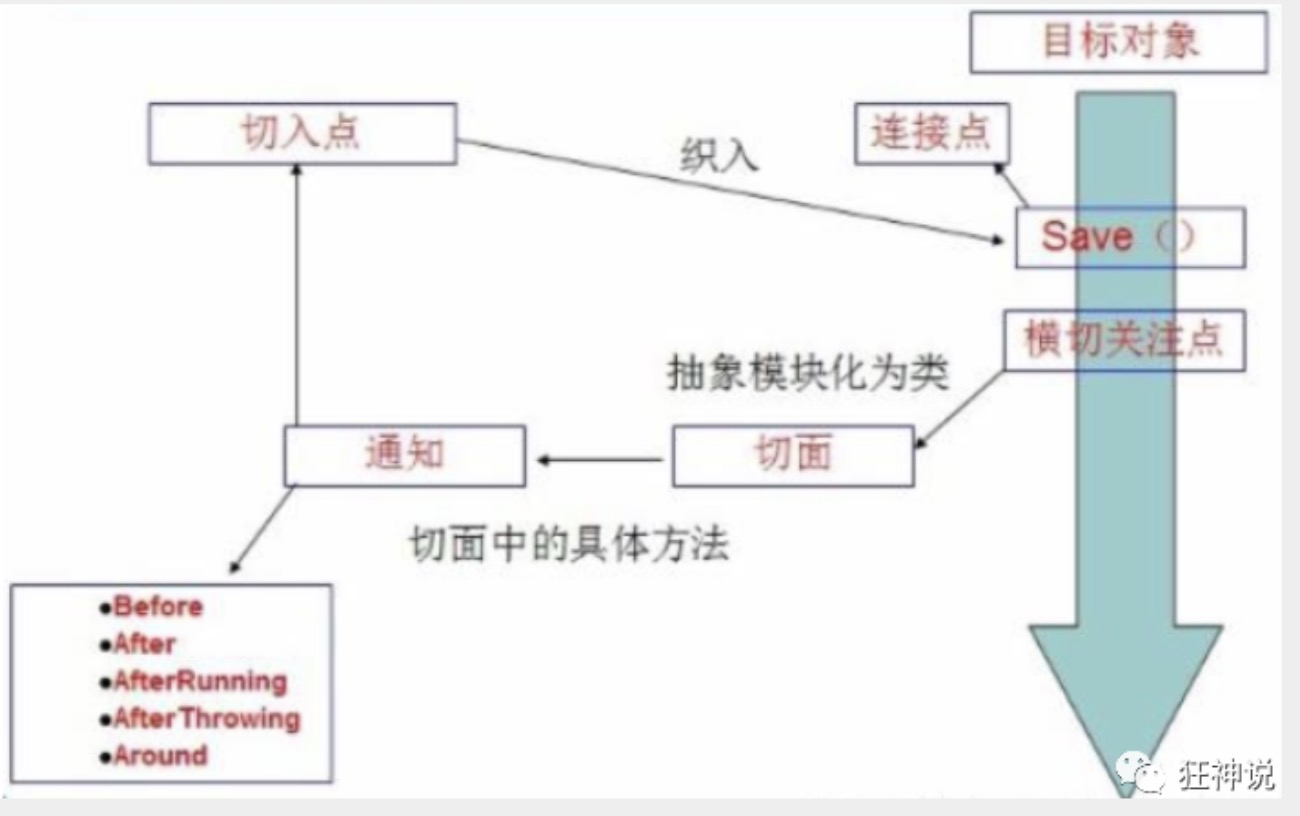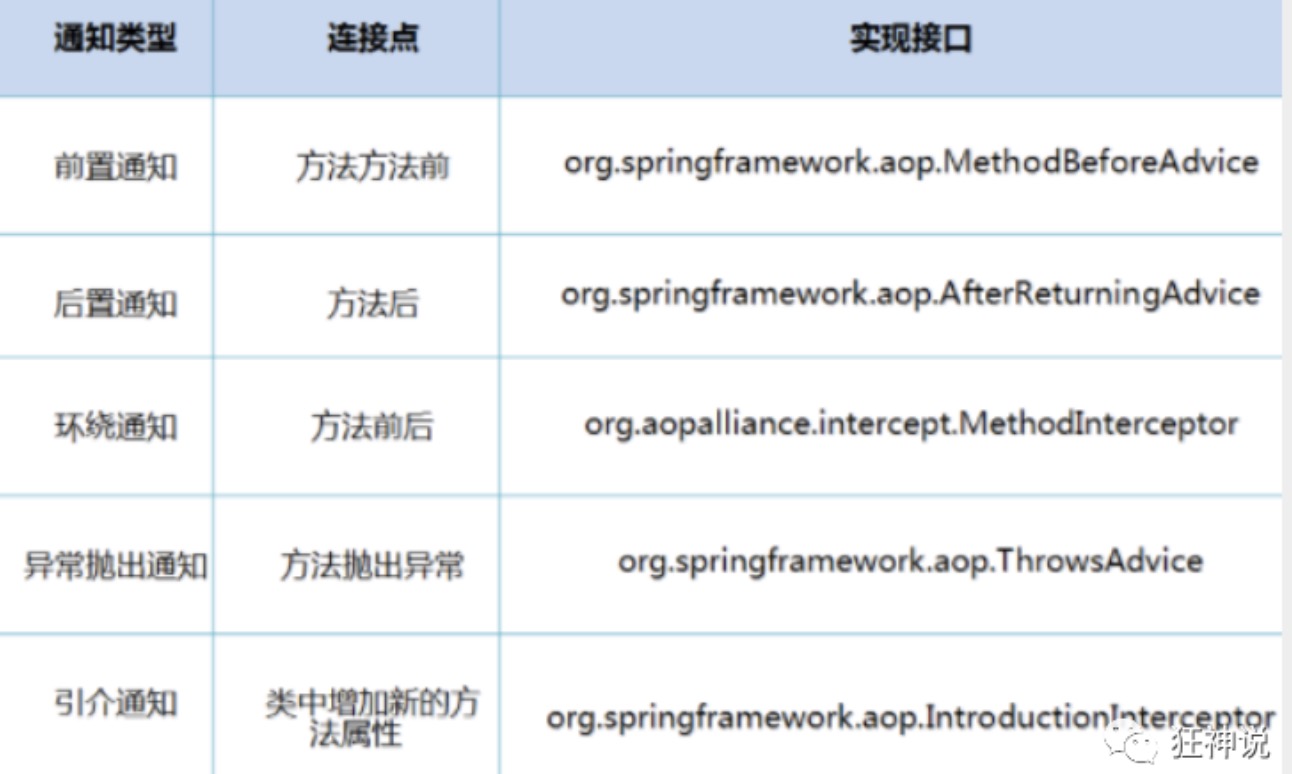一、什么是AOP
AOP(Aspect Oriented Programming)意为:面向切面编程,通过预编译方式和运行期动态代理实现程序功能的统一维护的一种技术。AOP是OOP的延续,是软件开发中的一个热点,也是Spring框架中的一个重要内容,是函数式编程的一种衍生范型。利用AOP可以对业务逻辑的各个部分进行隔离,从而使得业务逻辑各部分之间的耦合度降低,提高程序的可重用性,同时提高了开发的效率。
通过动态代理的方式,将需要注入切面的对象进行代理,在进行调用的时候,将公共的逻辑直接添加进去,而不需要修改原有业务的逻辑代码,只需要在原来的业务逻辑基础之上做一些增强功能。

二、AOP在Spring中的作用
提供声明式事务;允许用户自定义切面
重要名词:
- 横切关注点:跨越应用程序多个模块的方法或功能。即是,与我们业务逻辑无关的,但是我们需要关注的部分,就是横切关注点。如日志 , 安全 , 缓存 , 事务等等 …
- 切面(ASPECT):横切关注点 被模块化 的特殊对象。即,它是一个类。
- 通知(Advice):切面必须要完成的工作。即,它是类中的一个方法。
- 目标(Target):被通知对象。
- 代理(Proxy):向目标对象应用通知之后创建的对象。
- 切入点(PointCut):切面通知 执行的 “地点”的定义。
- 连接点(JointPoint):与切入点匹配的执行点。

SpringAOP中,通过Advice定义横切逻辑,Spring中支持5种类型的Advice:

即 Aop 在 不改变原有代码的情况下 , 去增加新的功能 。
三、使用Spring实现AOP
【重点】使用AOP织入,需要导入一个依赖包!
1
2
3
4
5
6
7
|
<dependency>
<groupId>org.aspectj</groupId>
<artifactId>aspectjweaver</artifactId>
<version>1.9.19</version>
<scope>runtime</scope>
</dependency>
|
3.1 execution表达式
例:execution( com.sample.service.impl…*.*(…))*
解释如下:
| 符号 |
含义 |
| execution() |
表达式的主体; |
| 第一个*符号 |
表示返回值的类型任意; |
| com.sample.service.impl |
AOP所切的服务的包名,即,我们的业务部分 |
| 包名后面的”…“ |
表示当前包及子包; |
| 第二个”*“ |
表示类名,*即所有类。 |
| .*(…) |
表示任何方法名,括号表示参数,两个点表示任何参数类型; |
3.2 方法一
通过 Spring API 实现
首先编写我们的业务接口和实现类
1
2
3
4
5
6
| public interface UserService {
public void add();
public void delete();
public void update();
public void search();
}
|
1
2
3
4
5
6
7
8
9
10
11
12
13
14
15
16
17
18
| public class UserServiceImpl implements UserService{
@Override
public void add() {
System.out.println("增加用户");
}
@Override
public void delete() {
System.out.println("删除用户");
}
@Override
public void update() {
System.out.println("更新用户");
}
@Override
public void search() {
System.out.println("查询用户");
}
}
|
然后去写我们的增强类 , 我们编写两个 , 一个前置增强 一个后置增强
1
2
3
4
5
6
7
8
9
| public class BeforeLog implements MethodBeforeAdvice {
@Override
public void before(Method method, Object[] objects, Object o) throws Throwable {
System.out.println( o.getClass().getName() + "的" + method.getName() + "方法被执行了");
}
}
|
1
2
3
4
5
6
7
8
9
10
11
12
| public class AfterLog implements AfterReturningAdvice {
@Override
public void afterReturning(Object o, Method method, Object[] objects, Object o1) throws Throwable {
System.out.println("执行了" + o1.getClass().getName()
+"的"+method.getName()+"方法,"
+"返回值:"+o);
}
}
|
最后去spring的文件中注册 , 并实现aop切入实现 , 注意导入约束 .
1
2
3
4
5
6
7
8
9
10
11
12
13
14
15
16
17
18
19
20
| <?xml version="1.0" encoding="UTF-8"?>
<beans xmlns="http://www.springframework.org/schema/beans"
xmlns:xsi="http://www.w3.org/2001/XMLSchema-instance" xmlns:aop="http://www.springframework.org/schema/aop"
xsi:schemaLocation="http://www.springframework.org/schema/beans http://www.springframework.org/schema/beans/spring-beans.xsd http://www.springframework.org/schema/aop https://www.springframework.org/schema/aop/spring-aop.xsd">
<bean id="userService" class="com.nichu.service.UserServiceImpl"/>
<bean id="log" class="com.nichu.log.BeforeLog"/>
<bean id="after" class="com.nichu.log.AfterLog"/>
<aop:config>
<aop:pointcut id="pointcut" expression="execution(* com.nichu.service.UserServiceImpl.*(..))"/>
<aop:advisor advice-ref="log" pointcut-ref="pointcut"/>
<aop:advisor advice-ref="after" pointcut-ref="pointcut"/>
</aop:config>
</beans>
|
测试
1
2
3
4
5
| public static void main(String[] args) {
ApplicationContext context = new ClassPathXmlApplicationContext("applicationContext.xml");
UserService userService = (UserService) context.getBean("userService");
userService.add();
}
|
3.3 方法二(推荐)
自定义类来实现Aop
目标业务类不变依旧是userServiceImpl
第一步 : 写我们自己的一个切入类
1
2
3
4
5
6
7
8
9
10
| public class DiyPointcut {
public void before(){
System.out.println("---------方法执行前---------");
}
public void after(){
System.out.println("---------方法执行后---------");
}
}
|
去spring中配置
1
2
3
4
5
6
7
8
9
10
11
12
13
14
15
|
<bean id="diy" class="com.nichu.pointcut.DiyPointCut"/>
<aop:config>
<aop:aspect ref="diy">
<aop:pointcut id="point" expression="execution(* com.nichu.service.UserServiceImpl.*(..))"/>
<aop:before method="before" pointcut-ref="point"/>
<aop:after method="after" pointcut-ref="point"/>
</aop:aspect>
</aop:config>
|
测试:
1
2
3
4
5
| public static void main(String[] args) {
ApplicationContext context = new ClassPathXmlApplicationContext("applicationContext.xml");
UserService userService = (UserService) context.getBean("userService");
userService.add();
}
|
3.4 方法三
使用注解实现
第一步:编写一个注解实现的增强类
1
2
3
4
5
6
7
8
9
10
11
12
13
14
15
16
17
18
19
20
21
22
| @Aspect
public class AnnotationPointcut {
@Before("execution(* com.nichu.service.UserServiceImpl.*(..))")
public void before(){
System.out.println("---------方法执行前---------");
}
@After("execution(* com.nichu.service.UserServiceImpl.*(..))")
public void after(){
System.out.println("---------方法执行后---------");
}
@Around("execution(* com.nichu.service.UserServiceImpl.*(..))")
public void around(ProceedingJoinPoint jp) throws Throwable {
System.out.println("环绕前");
System.out.println("签名:"+jp.getSignature());
Object proceed = jp.proceed();
System.out.println("环绕后");
System.out.println(proceed);
}
}
|
第二步:在Spring配置文件中,注册bean,并增加支持注解的配置
1
2
3
|
<bean id="annotationPointcut" class="com.nichu.config.AnnotationPointcut"/>
<aop:aspectj-autoproxy/>
|
aop:aspectj-autoproxy:说明
1
2
3
| 通过aop命名空间的<aop:aspectj-autoproxy />声明自动为spring容器中那些配置@aspectJ切面的bean创建代理,织入切面。当然,spring 在内部依旧采用AnnotationAwareAspectJAutoProxyCreator进行自动代理的创建工作,但具体实现的细节已经被<aop:aspectj-autoproxy />隐藏起来了
<aop:aspectj-autoproxy />有一个proxy-target-class属性,默认为false,表示使用jdk动态代理织入增强,当配为<aop:aspectj-autoproxy poxy-target-class="true"/>时,表示使用CGLib动态代理技术织入增强。不过即使proxy-target-class设置为false,如果目标类没有声明接口,则spring将自动使用CGLib动态代理。
|


